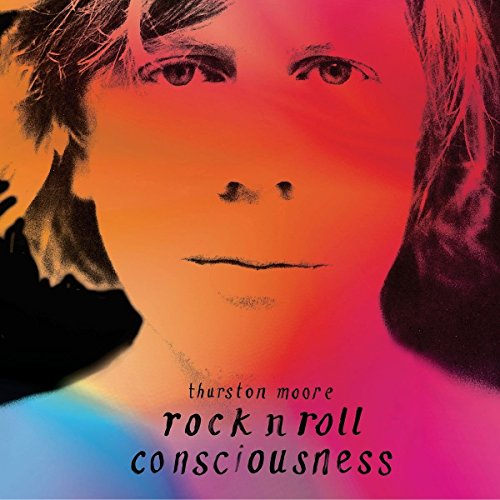
Thurston Moore
Rock N Roll Consciousness
Release Date: Apr 28, 2017
Genre(s): Pop/Rock, Alternative/Indie Rock
Record label: Caroline
Music Critic Score
How the Music Critic Score works
Buy Rock N Roll Consciousness from Amazon
Album Review: Rock N Roll Consciousness by Thurston Moore
Very Good, Based on 10 Critics
Based on rating 8/10
In its Season 6 finale, 'Partings,' everything in Gilmore Girls is up for grabs. Rory's relationship with Logan has a London-shaped hole in the middle, Lorelai and Luke have nothing left to offer as a couple, and even the creators of the show have walked away. That season had been something of a rebirth, striking out on a darker path and away from the warm narratives that had preceded it.
Based on rating 4/5
He piloted the experimental rock group Sonic Youth, champions avant-garde racket-makers such as Prurient and Boredoms, and is an advocate of free jazz, black metal and 50-minute passages of piercing amplifier feedback. Now, finally, Thurston Moore has hired Adele producer Paul Epworth for a late-career stab at the lucrative chart-pop market. His orchestral cover of Skyfall leaves much to be desired.
Based on rating 7.7/10
Though they personified the squall and squalor of 1980s Manhattan, Sonic Youth's hearts always belonged to 1960s California. Starting with 1985's Bad Moon Rising, Golden State roots both literal (see: Kim Gordon's Los Angeles upbringing) and figurative (Lee Ranaldo's Deadhead past) began to deeply entangle themselves in their knotty guitar gnarl. But where the Manson-inspired maelstrom of "Death Valley '69" seemed to add another gallon of piss onto the grave of the hippie dream, the content and iconography of Sonic Youth's subsequent work suggested they were secretly mourning it.
Based on rating 7/10
Reunited with his backing band for The Best Day -- My Bloody Valentine bassist Deb Googe, Nøught guitarist James Sedwards, and longtime drummer Steve Shelley, as well as poet/songwriter Radieux Radio -- Thurston Moore delves even deeper into that album's contemplative, redemptive side on Rock N Roll Consciousness. On songs like the bold yet reverent "Cusp," Moore and company explore spiritual, sexual, and emotional healing on a mystical level. With two tracks stretching beyond the ten-minute mark, Rock N Roll Consciousness' songs are consistently longer than Sonic Youth's output, but they're not just expanded; they're heightened.
Based on rating 7/10
With Sonic Youth having come to an end in 2011, his focus since then has primarily been on his solo work. Having concluded two years of touring to promote the 2015 release The Best Day, his new release has seen him stick with the same cast of musicians, which lends Rock n Roll Consciousness a very focused feel. The album saw a break from Moore's traditional working methods.
Based on rating 7/10
Thurston Moore spent a long time with that one band, but he’s continually collaborated with a variety of artists. Whether from jazz, rock, or another background, these artists—from Nels Cline to Yoko Ono to John Zorn to Mats Gustafsson—frequently fit with Moore’s general experimental sensibility while enabling him to follow different experimental paths. Since Sonic Youth’s ending in 2011, he’s put out a series of improvisational albums alongside (relatively) more traditional solo or band albums.
Based on rating 3/5
With Lee Ranaldo and Thurston Moore sharing joint custody of drummer Steve Shelley in the wake of Sonic Youth's possibly permanent but definitely ongoing hiatus, fans of the New York art rockers have certainly been getting more bang for their buck. Having relocated to London and continuing with the direction started on his previous album, The Best Day, Moore, along with My Bloody Valentine's Deb Goodge (bass) and guitarist James Sedwards (Chrome Hoof) and the aforementioned Shelley, is displaying a fine linear growth with Rock N Roll Consciousness. With five tracks in just over 42 minutes, you'd be forgiven for taking this album as an exercise in over-indulgence but it's the opposite that's true.
Based on rating 3/5
Clocking in at five songs, you'd be briefly nonplussed at Rock n Roll Consciousness if you didn't know better, if you didn't already know that within Thurston Moore's punk heart beats a man who loves to solo. The solos in Rock n Roll Consciousness are so long they refuse to even acknowledge that they are solos. They are instead mighty ocean-going voyages of noise.
Opinion: Excellent
In the wake of 1995's Psychic Hearts-- a sinewy, endless grab-bag--Thurston Moore's singer-songwriter albums strained to find an identity independent of Sonic Youth. This was a process. Moore was Moore, after all: a smart-ass, a downtown counterculture iconoclast, a walking music encyclopedia prone to punctuating guitar eruptions and searing feedback.
Opinion: Excellent
There's a tendency amongst chin-stroking musos to discuss the solo endeavours of Thurston Moore, Kim Gordon and Lee Ranaldo solely in relation to their tenures as members of Sonic Youth, which is exactly what I'm about to do. This is unsurprising given that each of them was a vital component in possibly the most influential and forward thinking guitar bands to grace both the 20th or 21st Centuries (drummer Steve Shelley was also vital of course, but given that he's now part of The Thurston Moore Band it's safe to say that he's not overly fussed about etching his own name into the annals of rock 'n' roll). However, this approach also tends to overlook the fact that, as part of a collective like Sonic Youth, components is all these musicians could ever really be.
'Rock N Roll Consciousness'
is available now

